Study on Modeling and Evaluating Alfalfa Yield and Optimal Water Use Efficiency in the Agro-Pastoral Ecotone of Northern China
Abstract
1. Introduction
2. Results
2.1. Model Calibration and Validation
2.2. Effects of Irrigation on Soil Water Content, Leaf Area Index, and Yield
2.2.1. Effects of Different Irrigation Gradients on Soil Water Content
2.2.2. Effects of Different Irrigation Amounts on Alfalfa Leaf Area
2.2.3. Effects of Different Irrigation Gradients on Alfalfa Yield
2.3. Dssat-Forage-Alfalfa Model Simulation Application
2.3.1. Different Simulated Scenario Settings
2.3.2. Effects of Different Initial Soil Moisture Contents and Irrigation Quotas on Alfalfa Yield
3. Discussion
3.1. Effects of Different Irrigation Gradients on Soil Moisture, Leaf Area, and Yield
3.2. Alfalfa Irrigation Scheduling and Yield Prediction Analysis
4. Materials and Methods
4.1. The Study Area
4.2. Field Management and Experimental Design
4.3. Data Collection and Methods
4.3.1. Meteorological Data
4.3.2. Soil Data
4.3.3. Alfalfa Field Management
4.3.4. Alfalfa Physiological and Ecological Indicators and Yield Determination
4.3.5. Soil Water Content Monitoring
4.4. Crop Growth Model
4.4.1. Soil Water Transport Equation
4.4.2. Crop Dry Matter Accumulation Equation
4.5. Model Calibration and Validation
5. Conclusions
- (1)
- The simulation accuracy of the constructed model is acceptable. The Average Relative Error (ARE) is less than 10% and Normalized Root Mean Square Error (ENRMS) is less than 15%, while R2 is equal to or exceeding 0.85.
- (2)
- Water consumption in the surface soil layer (0–20 cm) of the alfalfa was 6~12% and 13~31% more than that in the deeper soil layers of 20~40 cm and 40~60 cm, respectively. Leaf area in the second year was 7.90~10.32% larger than that in the first year. The yield of the second harvest was 800~1300 kg/ha greater than that of the first harvest.
- (3)
- An irrigation scheme with an irrigation quota of 300 mm and irrigating ten times during the growth period was recommended. To ensure the maximization of alfalfa turning green rate, while ensuring efficient utilization of water resources and economic benefits, it was recommended to control the initial soil water content to 0.8 θfc~1.0 θfc and have an irrigation quota of 30 mm.
Author Contributions
Funding
Data Availability Statement
Acknowledgments
Conflicts of Interest
References
- Duan, D.; Zhao, L.; Zhao, F. Application of alfalfa silage on cattle and sheep feed. Feed Res. 2023, 20, 169–172. [Google Scholar]
- Wang, Q.; Xie, J.; Yu, L. Research Progress and Prospect of Alfalfa Breeding in China. J. Grassl. Forage Sci. 2023, 4, 1–7. [Google Scholar]
- Quan, J.; Li, X.; Gan, H. Adaptability of 43 Medicago sativa varieties in the irrigated agricultural area of Zhangye, Gansu Province. Pratac. Sci. 2023, 40, 1888–1901. [Google Scholar]
- Duan, Y.; Tuo, D.; Zhao, P. Crops caloric value and adjustment of planting structure in rainfed farmland of north Yinshan Mountian area, Inner Mongolia. J. Arid Land Resour. Environ. 2013, 27, 1–15. [Google Scholar]
- Kang, W.; Shi, X.; Duan, H. Analysis of Water Requirement and Water Requirement Law of Main Crops in Dryland Area at The Northern Foot of Yinshan Mountain. J. Tianjin Agric. Sci. 2023, 29, 13–20. [Google Scholar]
- Zhang, Y.; Liang, Z.; Sui, L. Effect on physiological characteristic of Medicago sativa under saline-alkali stress at seeding stage. Acta Pratac. Sin. 2009, 18, 230–235. [Google Scholar]
- Ma, Y.; Wang, J.; Wang, C. Effects of water and fertilizer regulation on yield, quality and water and nitrogen use efficiency of alfalfa. Water Conserv. Plan. Des. 2023, 7, 88–95. [Google Scholar]
- Tian, D.; Hou, C.; Xu, B. Combined Effect of Water and Salt Stress on Growth and Physiological Traits of Alfalfa at Branching Stage. J. Iirrigation Drain. 2023, 4, 8–14. [Google Scholar]
- Tong, C.; Li, H.; Niu, H. TheImpact of Soil Moisture Control on Crop Coefficient and Water Use Efficiency of Drip-irrigated Alfalfa. Chin. Agric. Sci. Bull. 2019, 39, 74–79. [Google Scholar]
- Ma, M.; Zhao, J.; Li, D. Effects of alflfa different irrigation methods on soil moisture and irrigation water use efficiency. Xinjiang Agric. Sci. 2023, 60, 2306–2313. [Google Scholar]
- Zheng, H.; Wang, B.; Cao, X. Optimization of Subsurface Drip Irrigation Schedule of Alfalfa in Northwest China. Water 2023, 15, 2242. [Google Scholar] [CrossRef]
- Wang, X.; Huang, W.; Yu, S. Effect of water and fertilizer coupling on seed yield and composition of alfalfa grown with underground drip irrigation in Ningxia. Acta Pratac. Sin. 2019, 31, 76–85. [Google Scholar]
- Jones, J.W.; Hoogenboom, G.; Porter, C.H. The DSSAT cropping system model. Eur. J. Agron. 2003, 18, 235–265. [Google Scholar] [CrossRef]
- Abayechaw, D. Review on decision support system for agrotechnology transfer (DSSAT) model. Int. J. Intell. Inf. Syst. 2021, 10, 117–124. [Google Scholar] [CrossRef]
- Tan, H.; Lv, X.; Zhang, Z. Influence of Climate Change on Cotton Production Potential Based on DSSAT Model Simulation. Cott. Sci. 2019, 32, 113–120. [Google Scholar]
- Wang, Y. Simulation and Verification of Crop Growth Models with DifferentDrip Irrigation Models of Xinjiang Spring Wheat. Shihezi Univ. 2020, 2020, 789. [Google Scholar]
- Ge, J.; Yu, Z.; Gong, X. Evaluation of Irrigation Modes for Greenhouse Drip Irrigation Tomatoes Based on AquaCrop and DSSAT Models. Plants 2023, 12, 3863. [Google Scholar] [CrossRef]
- Wang, B.; Yang, H.; Feng, J. Rice Genotype Coefficient Optimization of DSSAT Based on PSO. Trans. Chin. Soc. Agric. Mach. 2023, 54, 369–375. [Google Scholar]
- Zhu, B.; Chen, S.; Xu, Z. The Estimation of Maize Grain Protein Content and Yield by Assimilating LAI and LNA, Retrieved from Canopy Remote Sensing Data, into the DSSAT Model. Remote Sens. 2023, 15, 2576. [Google Scholar] [CrossRef]
- Wang, Y.; Jiang, K.; Shen, H. Decision-making method for maize irrigation in supplementary irrigation areas based on the DSSAT model and a genetic algorithm. Agric. Water Manag. 2023, 280, 108231. [Google Scholar] [CrossRef]
- Song, L. Simulation of Maize Growth and Yield under Climate Change in China; Northwest A&F University: Xianyang, China, 2021. [Google Scholar]
- Xiang, Z.; Bailey, R.T.; Kisekka, I. Using DSSAT-MODFLOW to determine the controls of groundwater storage and crop yield in groundwater-based irrigated regions. J. Hydrol. 2022, 612, 128161. [Google Scholar] [CrossRef]
- Shen, H.; Gao, Y.; Guo, F. A modified DSSAT-CERES model for simulating summer maize growth under film mulching. Agron. J. 2021, 113, 4819–4831. [Google Scholar] [CrossRef]
- Qu, C.; Li, X.; Hui, J.U. The impacts of climate change on wheat yield in the Huang-Huai-Hai Plain of China using DSSAT-CERES-Wheat model under different climate scenarios. J. Integr. Agric. 2019, 18, 1379–1391. [Google Scholar] [CrossRef]
- Xin, M. Coupling Effect of Water and Nitrogen on Controlled Release Fertilizer Application and Optimization of Irrigation and Fertilization System in Salinized Irrigated Area; Inner Mongolia Agricultural University: Hohhot, China, 2022. [Google Scholar]
- Wang, X.; Xin, L.; Du, J. Simulation of Cotton Growth and Yield under Film Drip Irrigation Condition Based on DSSAT Model in Southern Xinjiang. Trans. Chin. Soc. Agric. Mach. 2022, 53, 314–321. [Google Scholar]
- Du, J.; Wang, Z.; Yu, H. Optimum winter irrigation amount of subsurface drip irrigation in alfalfa grassland. Agric. Res. Arid Areas 2019, 38, 166–172. [Google Scholar]
- Zhang, S. Research on the Key Technical Parameters and Optimizingirrigation Schedule in Underground Drip Irrigation; Inner Mongolia Agricultural University: Hohhot, China, 2018. [Google Scholar]
- Hou, C. Effect Mechanism of Water and Salt Stress on Water and NitrogenUtilization and Physiological Characteristics of Alfalfa in Hetao Irrigation Area; Inner Mongolia Agricultural University: Hohhot, China, 2022. [Google Scholar]
- Wu, J.; Miao, S.; Xu, B. Distribution of Stable Hydrogen and Oxygen Isotopes in the Root Zone of Alfalfa under Drip Irrigation. J. Irrig. Drain. 2017, 36, 14–17. [Google Scholar]
- Tian, D.; Hou, C.; Xu, B. Effect of Alfalfa on Water Consumption Process and Salt Changes in Fields. Trans. Chin. Soc. Agric. Mach. 2019, 50, 291–301. [Google Scholar]
- Meng, F.; Jin, N.; Wang, Z. Effects of light and water on alfalfa growth and water use. Prata. L Sci. 2023, 40, 2121–2128. [Google Scholar]
- Tong, C.; Li, H.; Bai, B. The Optimal Irrigation System of Alfalfa Based on WIN ISAREG Model. Chin. Agric. Sci. Bull. 2016, 32, 113–118. [Google Scholar]
- Wang, X.; Mi, F.; Li, H. Comparison of yield, nutrition quality and winter surviving rate of alfalfa varieties with different fall dormancy levels. J. Northwest Sci-Tech Univ. Agric. For. Nat. Sci. Ed. 2019, 47, 7–22. [Google Scholar]
- Bao, J. The Response of Alfalfa Planting and Harvesting Schemes to its Growth Periods; Inner Mongolia Agricultural University: Hohhot, China, 2020. [Google Scholar]
- Zhu, Y.; Tang, L.; Liu, L. Research Progress on the Crop Growth Model Crop Grow. Sci. Agric. Sin. 2019, 53, 3235–3256. [Google Scholar]
- Sarkar, R. Use of DSSAT to model cropping systems. CABI Rev. 2009, 1–12. [Google Scholar] [CrossRef]
- Wang, P. Research of Optimizing Deficit Irrigation for Sugarcane in Guangxi Province Using the DSSAT Model Based on Genetic Algorithm; Hebei University of Engineering: Handan, China, 2022. [Google Scholar]
- Sun, Y.; Sun, S.; Li, M. Study on high and stable yield area of soybean in Northeast China based on DSSAT model. Chin. J. Agric. Resour. Reg. Plan. 2023, 1008, 1–16. [Google Scholar]
- Li, Y.; Shi, P. Optimization of irrigation scheduling for spring wheat in Hetao Plain with DSSAT model. J. Nat. Sci. Beijing Norm. Univ. 2020, 56, 728–739. [Google Scholar]
- Yang, X.; Zheng, L.; Yang, Q. Modelling the effects of conservation tillage on crop water productivity, soil water dynamics and evapotranspiration of a maize-winter wheat-soybean rotation system on the Loess Plateau of China using APSIM. Agric. Syst. 2018, 166, 111–123. [Google Scholar] [CrossRef]

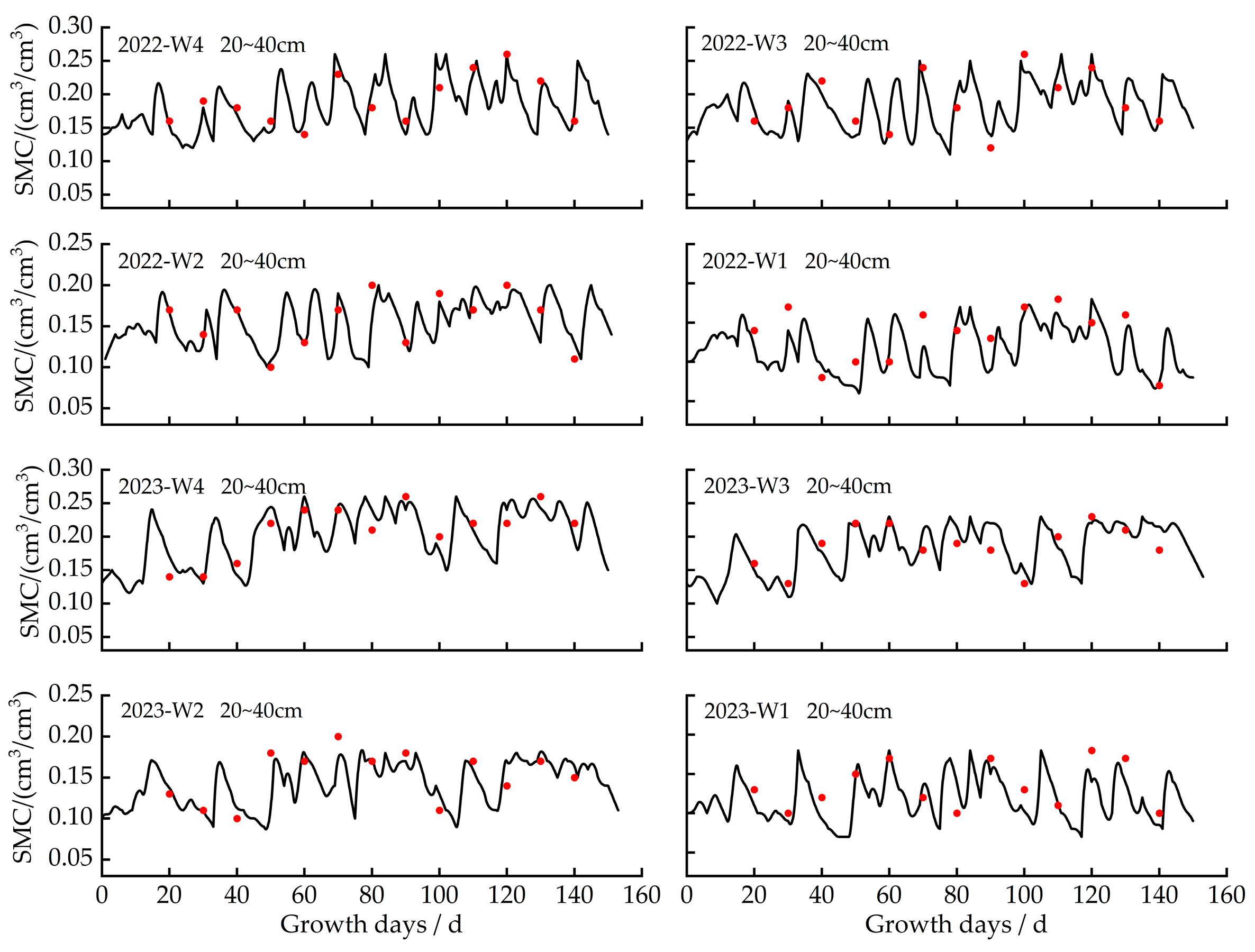
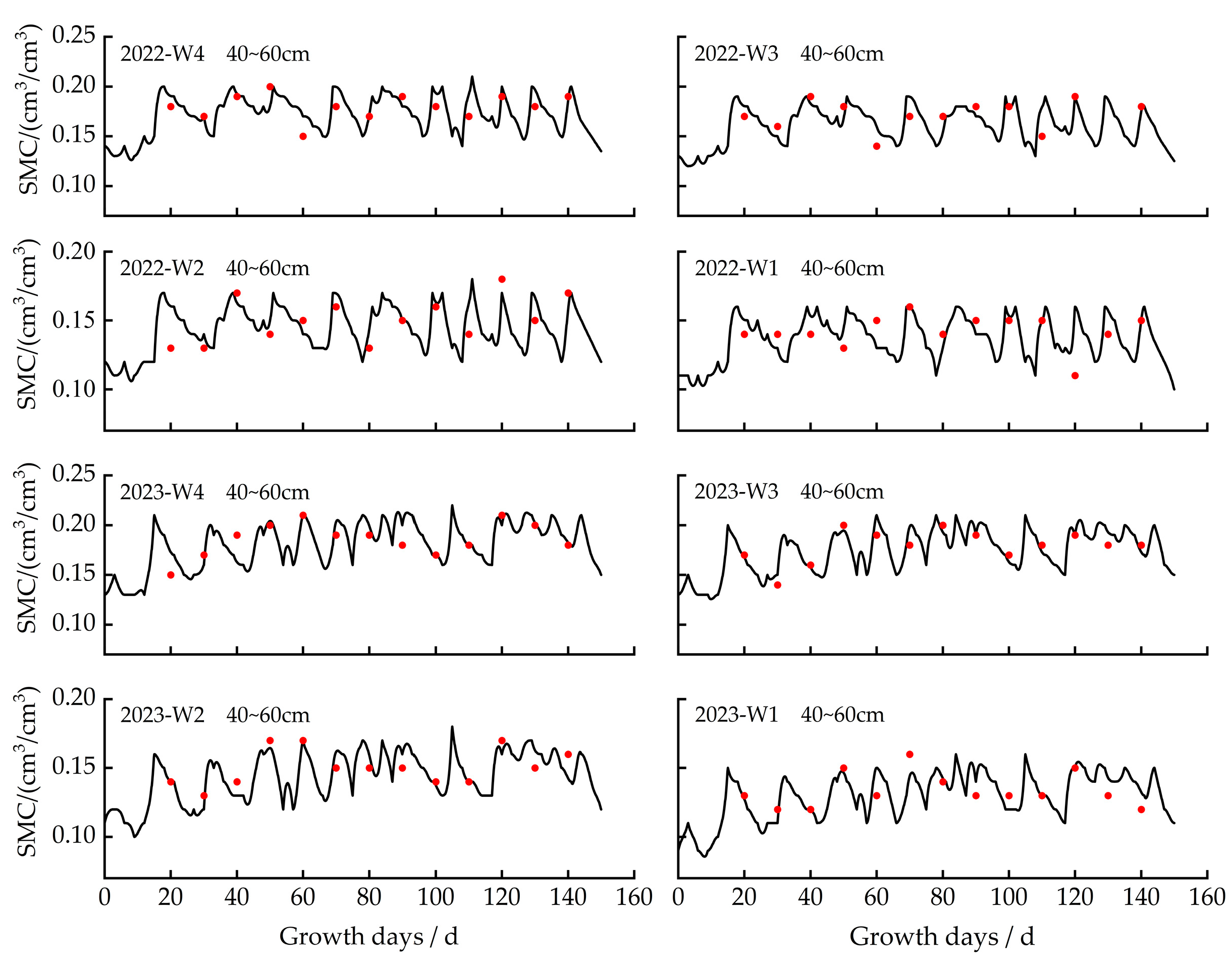
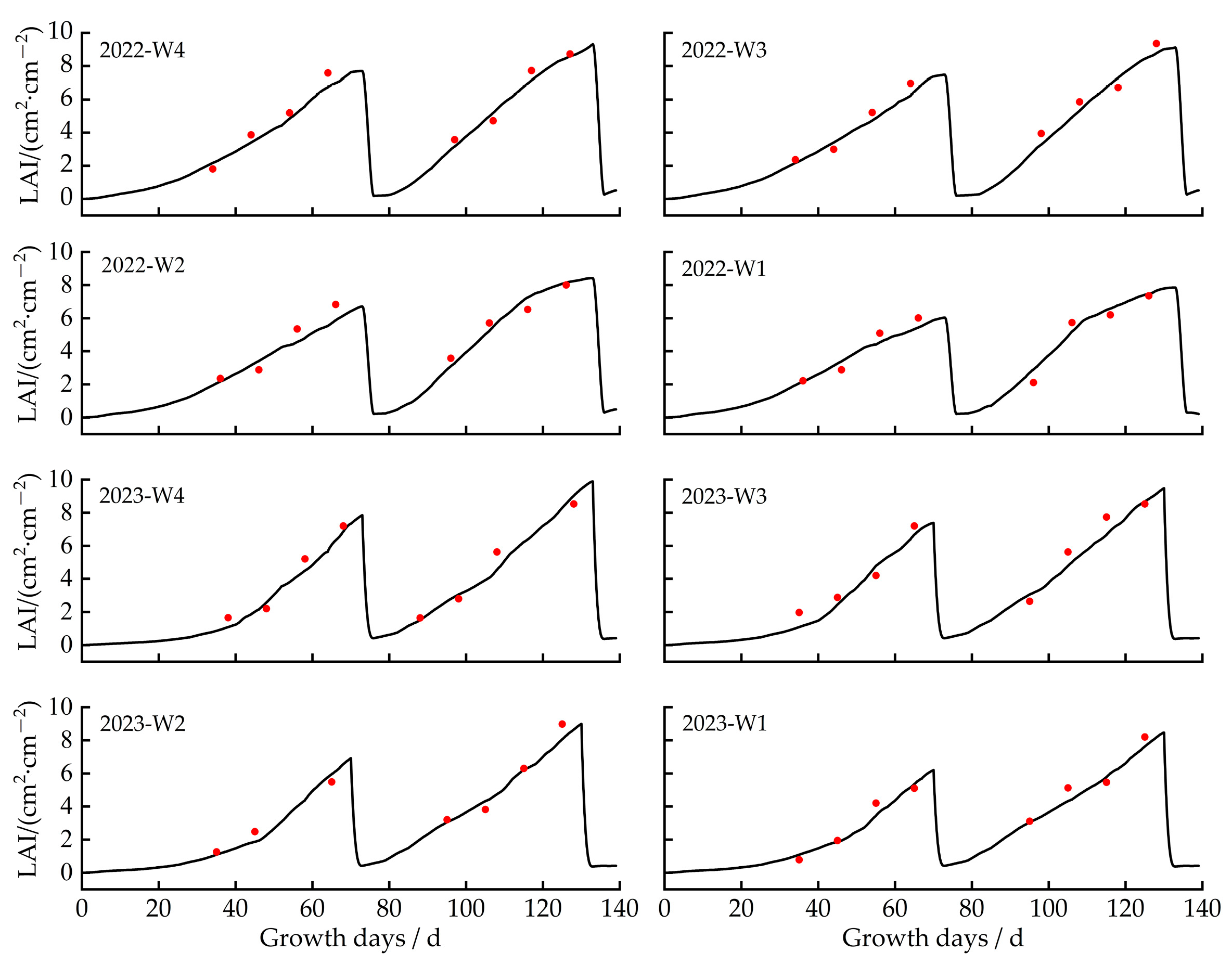

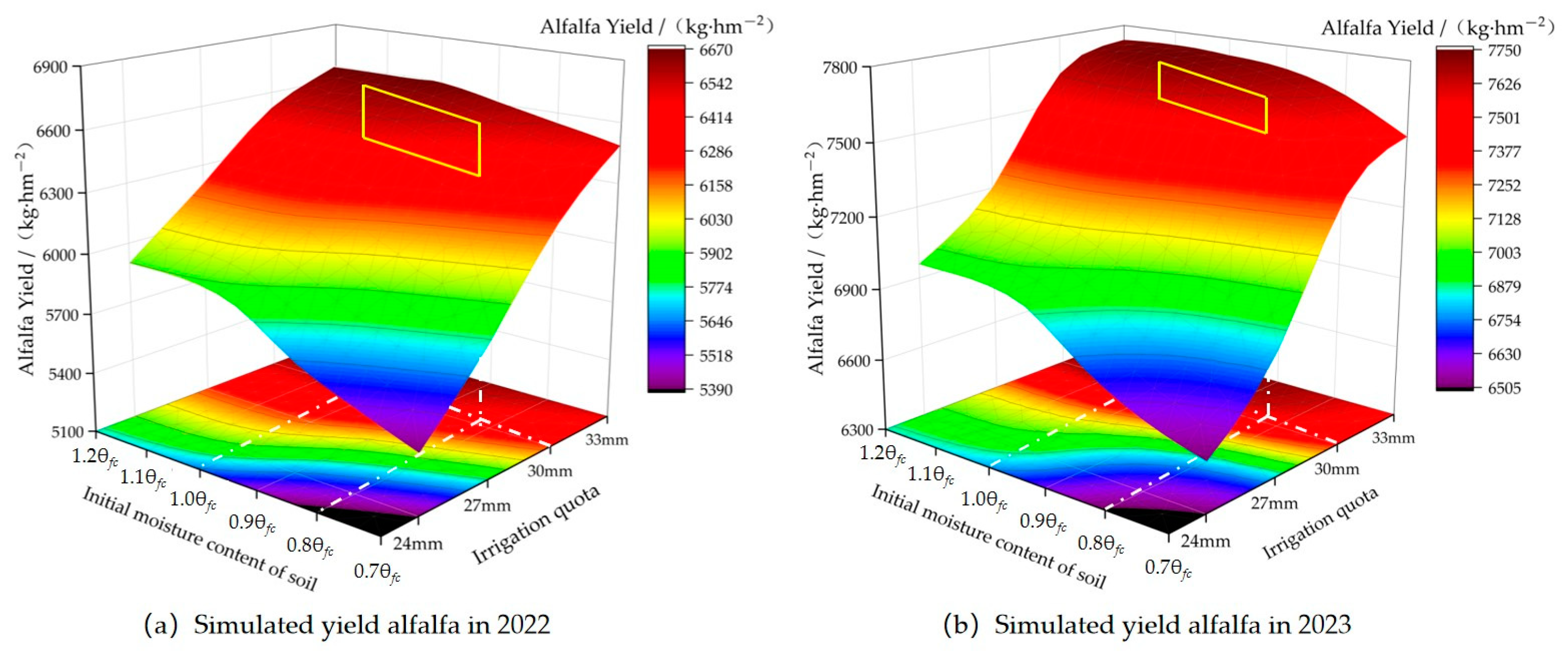
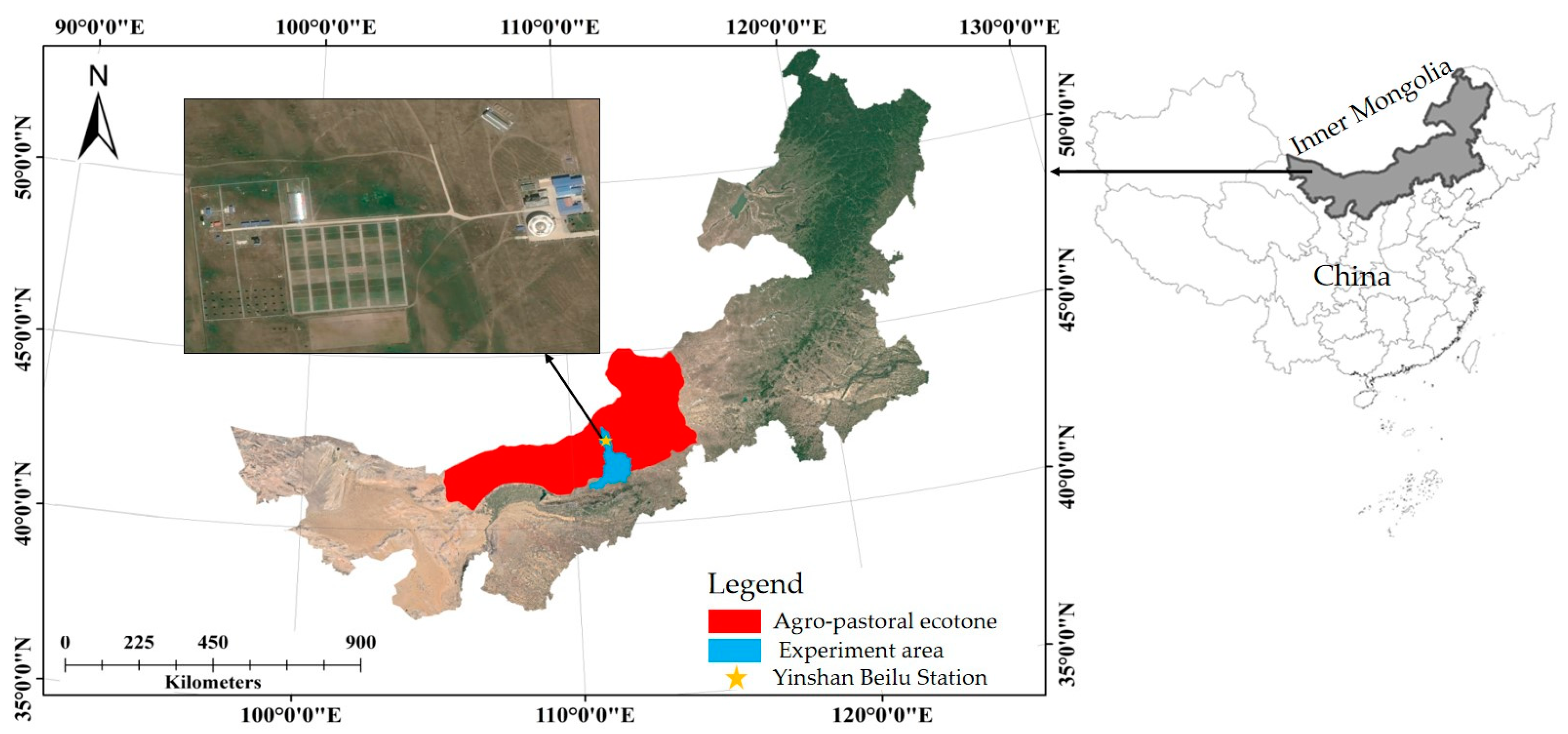
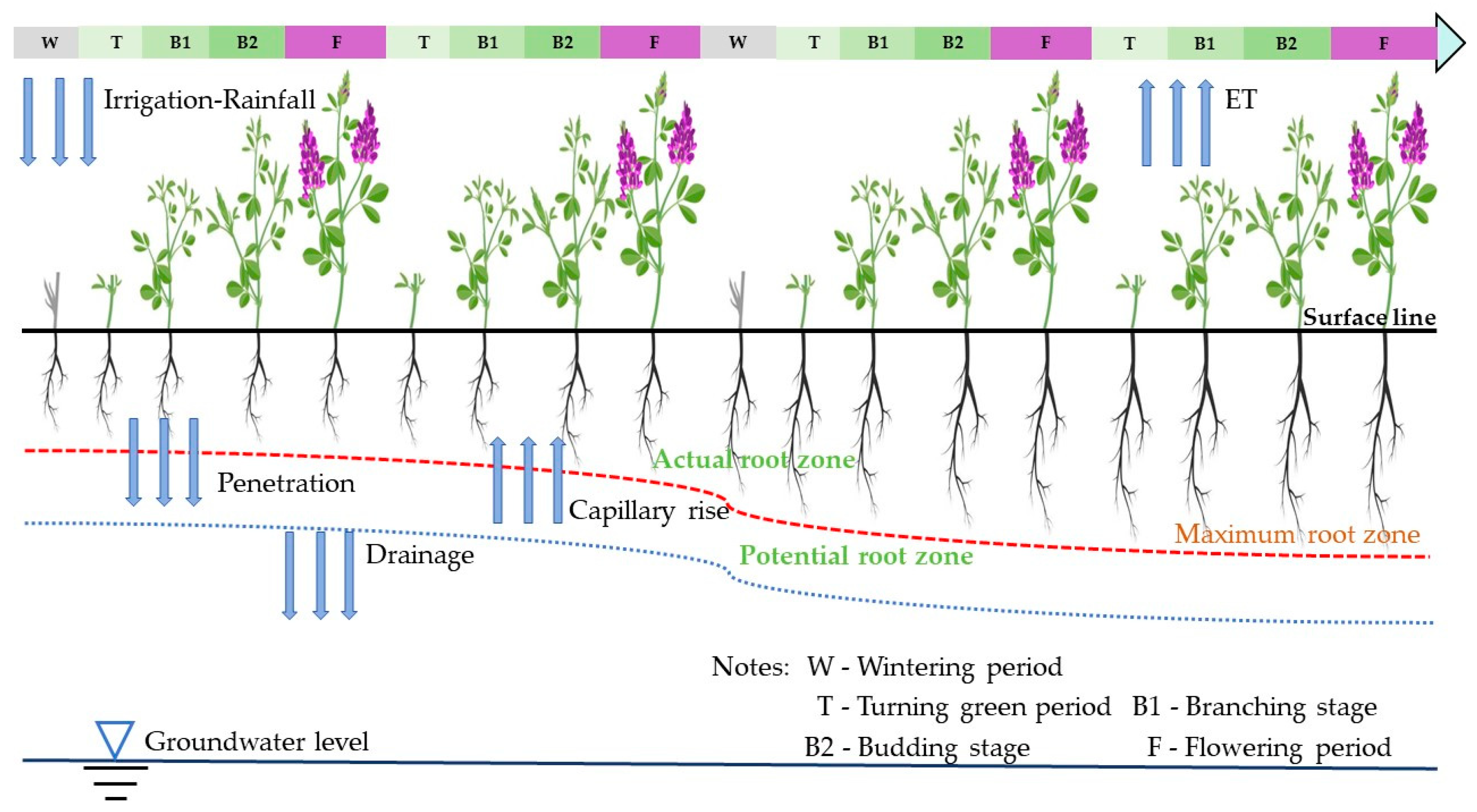
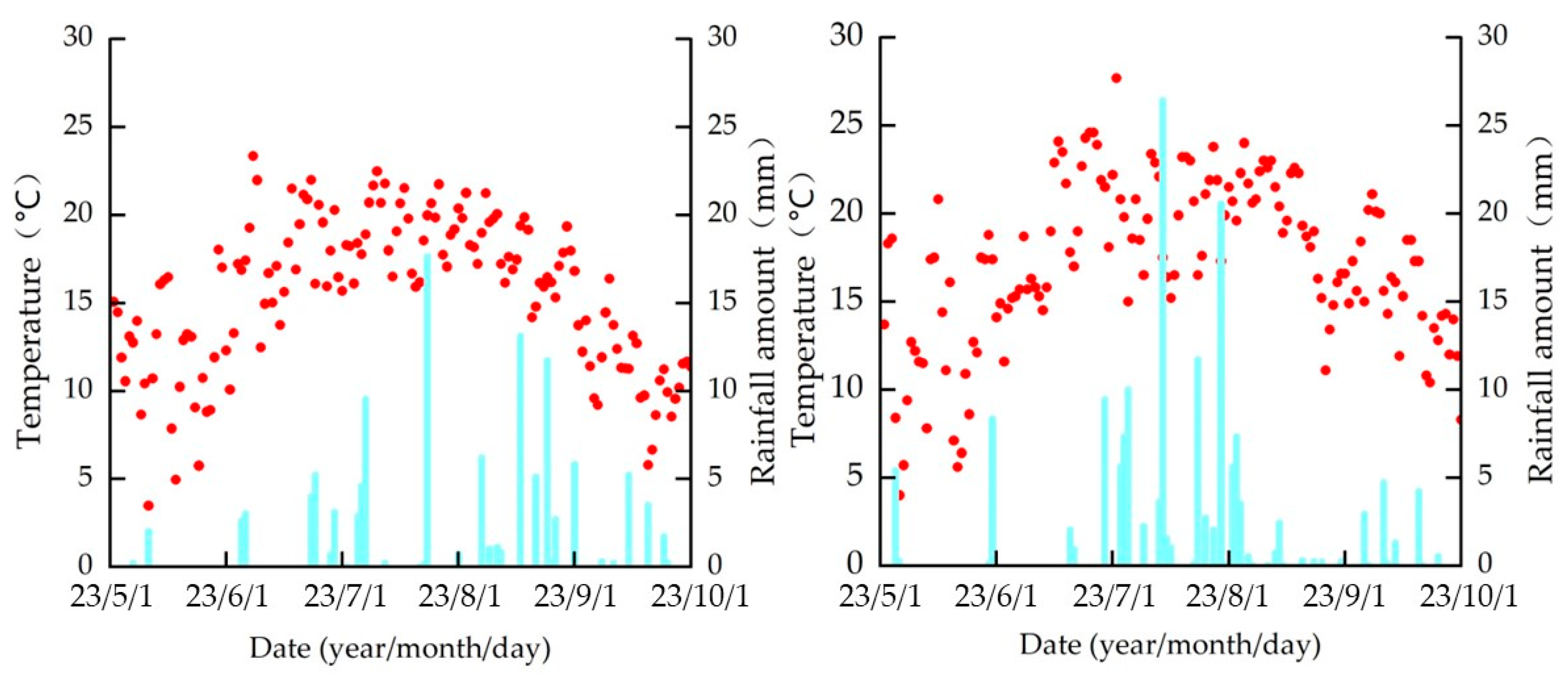
| Test Treatment | Statistical Index | ARE% | ENRMS | R2 | |
|---|---|---|---|---|---|
| 2022 (Model calibration) | 33 mm | LAI/(cm2·cm−2) | 6.68 | 10.38 | 0.90 |
| Yield/(kg·hm−2) | 5.87 | 10.74 | 0.89 | ||
| 30 mm | LAI/(cm2·cm−2) | 7.67 | 11.9 | 0.88 | |
| Yield/(kg·hm−2) | 4.49 | 9.91 | 0.91 | ||
| 27 mm | LAI/(cm2·cm−2) | 8.87 | 13.47 | 0.85 | |
| Yield/(kg·hm−2) | 5.53 | 10.26 | 0.90 | ||
| 24 mm | LAI/(cm2·cm−2) | 5.34 | 9.38 | 0.92 | |
| Yield/(kg·hm−2) | 3.77 | 9.26 | 0.93 | ||
| 2023 (Model validation) | 33 mm | LAI/(cm2·cm−2) | 7.46 | 11.63 | 0.88 |
| Yield/(kg·hm−2) | 3.86 | 9.47 | 0.92 | ||
| 30 mm | LAI/(cm2·cm−2) | 8.11 | 12.88 | 0.87 | |
| Yield/(kg·hm−2) | 5.61 | 10.37 | 0.91 | ||
| 27 mm | LAI/(cm2·cm−2) | 6.52 | 10.27 | 0.91 | |
| Yield/(kg·hm−2) | 2.94 | 8.91 | 0.94 | ||
| 24 mm | LAI/(cm2·cm−2) | 7.97 | 12.11 | 0.88 | |
| Yield/(kg·hm−2) | 5.23 | 10.06 | 0.91 |
| Test Treatment | Soil Depth/cm | ARE/% | ENRMS | R2 | |
|---|---|---|---|---|---|
| 2022 (Model calibration) | 33 mm | 0~20 | 4.39 | 12.72 | 0.87 |
| 20~40 | 2.26 | 9.42 | 0.92 | ||
| 40~60 | 1.45 | 9.03 | 0.93 | ||
| 30 mm | 0~20 | 3.64 | 11.27 | 0.88 | |
| 20~40 | 1.92 | 9.87 | 0.92 | ||
| 40~60 | 3.08 | 10.51 | 0.90 | ||
| 27 mm | 0~20 | 5.73 | 14.53 | 0.85 | |
| 20~40 | 4.67 | 10.64 | 0.89 | ||
| 40~60 | 3.32 | 10.26 | 0.90 | ||
| 24 mm | 0~20 | 4.76 | 13.42 | 0.86 | |
| 20~40 | 3.10 | 11.09 | 0.89 | ||
| 40~60 | 1.03 | 8.79 | 0.95 | ||
| 2023 (Model validation) | 33 mm | 0~20 | 5.04 | 13.73 | 0.87 |
| 20~40 | 4.66 | 10.13 | 0.90 | ||
| 40~60 | 2.38 | 9.66 | 0.92 | ||
| 30 mm | 0~20 | 4.12 | 12.24 | 0.88 | |
| 20~40 | 3.70 | 11.74 | 0.89 | ||
| 40~60 | 1.99 | 9.94 | 0.92 | ||
| 27 mm | 0~20 | 4.06 | 12.08 | 0.89 | |
| 20~40 | 1.84 | 9.68 | 0.93 | ||
| 40~60 | 1.01 | 8.49 | 0.95 | ||
| 24 mm | 0~20 | 4.87 | 13.34 | 0.87 | |
| 20~40 | 3.69 | 10.88 | 0.90 | ||
| 40~60 | 1.63 | 9.46 | 0.93 |
| Argument | Definition | Calibrated Value |
|---|---|---|
| CSDL | Critical short day duration (h) | 10.5 |
| PPSEN | Relative response slope to photoperiod (1/h) | 0.2 |
| EM-FL | Duration of light and heat from seedling emergence to first blossom appearance (d) | 21.5 |
| FL-SH | From the initial inflorescence blossoming to the first inflorescence fruit setting, light, and heat conditions (d) | 6.7 |
| SD-PM | Photothermal duration from seed production to the first inflorescence’s physiological ripening (d) | 33.5 |
| FL-LF | The photothermal time between the flowering of the first inflorescence and the cessation of leaf expansion (d) | 16 |
| LFMAX | Maximum photosynthetic rate of leaves (mg CO2/m2·s−1) | 2.4 |
| SLAVR | Specific leaf area (cm2/g) | 300 |
| SIZLF | Maximum blade size (cm2) | 5 |
| Harvest Stage | Growth Stage | Irrigation Date | Irrigation Quota/mm | ||||
|---|---|---|---|---|---|---|---|
| 2022 | 2023 | W1 | W2 | W3 | W4 | ||
| First harvest | Turning green | 16 May | 15 May | 24 | 27 | 30 | 33 |
| Branching | 7 June | 6 June | 24 | 27 | 30 | 33 | |
| 20 June | 22 June | 24 | 27 | 30 | 33 | ||
| Budding | 1 July | 3 July | 24 | 27 | 30 | 33 | |
| Flowering | 13 July | 19 July | 24 | 27 | 30 | 33 | |
| Second harvest | Turning green | 30 July | 4 August | 24 | 27 | 30 | 33 |
| Branching | 15 August | 17 August | 24 | 27 | 30 | 33 | |
| 27 August | 29 August | 24 | 27 | 30 | 33 | ||
| Budding | 5 September | 7 September | 24 | 27 | 30 | 33 | |
| Flowering | 16 September | 17 September | 24 | 27 | 30 | 33 | |
| Total | 240 | 270 | 300 | 330 | |||
| Harvest Stage | Growth Stage | Fertilization Date | Fertilization Type | The Application Rate of Fertilizer/kg·hm−2 | ||
|---|---|---|---|---|---|---|
| 2022 | 2023 | 2022 | 2023 | |||
| First harvest | Turning green | 16 May | 15 May | Urea | 150 | 150 |
| Branching | 20 June | 22 June | Urea | 150 | 150 | |
| Second harvest | Turning green | 30 July | 4 August | Urea | 150 | 150 |
| Branching | 27 August | 29 August | Urea | 150 | 150 | |
| Total | 600 | 600 | ||||
| Soil Depth | Clay% | Silt% | Sand% | Soil Bulk Density | Wilting Coefficient | Field Capacity | Saturated Water Content |
|---|---|---|---|---|---|---|---|
| (cm) | (<0.02 mm) | (0.02~0.5 mm) | (0.5~2 mm) | (g/cm3) | (cm3/cm3) | (cm3/cm3) | (cm3/cm3) |
| 0–20 | 3.42 | 48.47 | 48.47 | 1.47 | 0.07 | 0.38 | 0.43 |
| 20–40 | 3.08 | 18.58 | 78.34 | 1.59 | 0.07 | 0.34 | 0.39 |
| 40–60 | 2.69 | 11.56 | 85.75 | 1.63 | 0.07 | 0.32 | 0.37 |
| 60–80 | 2.54 | 10.03 | 87.43 | 1.69 | 0.09 | 0.32 | 0.36 |
| 80–100 | 1.46 | 8.87 | 89.67 | 1.74 | 0.09 | 0.28 | 0.34 |
Disclaimer/Publisher’s Note: The statements, opinions and data contained in all publications are solely those of the individual author(s) and contributor(s) and not of MDPI and/or the editor(s). MDPI and/or the editor(s) disclaim responsibility for any injury to people or property resulting from any ideas, methods, instructions or products referred to in the content. |
© 2024 by the authors. Licensee MDPI, Basel, Switzerland. This article is an open access article distributed under the terms and conditions of the Creative Commons Attribution (CC BY) license (https://creativecommons.org/licenses/by/4.0/).
Share and Cite
Miao, X.; Wang, G.; Li, R.; Xu, B.; Zheng, H.; Tian, D.; Wang, J.; Ren, J.; Li, Z.; Zhou, J. Study on Modeling and Evaluating Alfalfa Yield and Optimal Water Use Efficiency in the Agro-Pastoral Ecotone of Northern China. Plants 2024, 13, 229. https://doi.org/10.3390/plants13020229
Miao X, Wang G, Li R, Xu B, Zheng H, Tian D, Wang J, Ren J, Li Z, Zhou J. Study on Modeling and Evaluating Alfalfa Yield and Optimal Water Use Efficiency in the Agro-Pastoral Ecotone of Northern China. Plants. 2024; 13(2):229. https://doi.org/10.3390/plants13020229
Chicago/Turabian StyleMiao, Xiangyang, Guoshuai Wang, Ruiping Li, Bing Xu, Hexiang Zheng, Delong Tian, Jun Wang, Jie Ren, Zekun Li, and Jie Zhou. 2024. "Study on Modeling and Evaluating Alfalfa Yield and Optimal Water Use Efficiency in the Agro-Pastoral Ecotone of Northern China" Plants 13, no. 2: 229. https://doi.org/10.3390/plants13020229
APA StyleMiao, X., Wang, G., Li, R., Xu, B., Zheng, H., Tian, D., Wang, J., Ren, J., Li, Z., & Zhou, J. (2024). Study on Modeling and Evaluating Alfalfa Yield and Optimal Water Use Efficiency in the Agro-Pastoral Ecotone of Northern China. Plants, 13(2), 229. https://doi.org/10.3390/plants13020229





